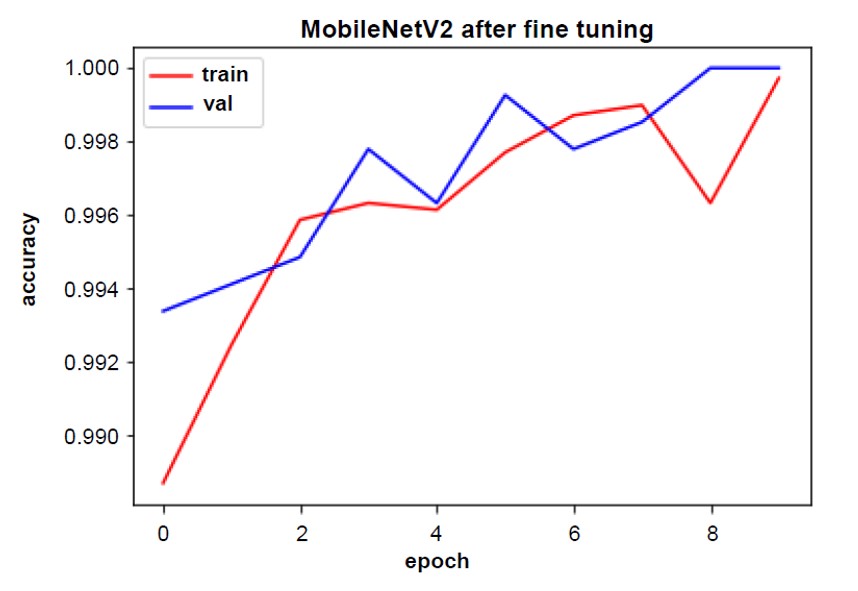Improving rotten fruit classification accuracy through fusion of multiple pretrained CNN models
Main Article Content
Abstract
Agriculture has been the main source of livelihood in Indonesia. The main sector lives in fruit sales, which are important for our healthcare. That is why it is important to keep the fruits fresh into the market. To address this issue, machine learning can help identify rotten fruits with deep learning techniques to differentiate fresh fruit from rotten fruit. Some deep learning techniques will be used in this classification, such as VGG16, MobileNetV2, Xception, ResNet-50, and InceptionV3, which are the common models used in fruit classification in some research. Every model will use fine tuning to increase its performance. The fusion model method will also be used in the classification to improve the performance of the model. Lastly, all of the models will be compared to see which is the best model for classification. In the end, there is a model with the best accuracy, which is MobileNetV2, with 0.99706 accuracy before the fusion model. The result of the fusion model gives the best accuracy, with 0.99926 accuracy. These results showed that the fusion model was best used for fruit classification and can help supermarkets classify rotten and fresh fruits, preventing more issues in the future. Still, this paper did not represent all of the machine learning classification algorithms. Further research is needed to compare the performance of different deep learning approaches in detecting rotten fruit in supermarkets.
Article Details

This work is licensed under a Creative Commons Attribution-NonCommercial-NoDerivatives 4.0 International License.
This work is licensed under a Creative Commons Attribution-NonCommercial-NoDerivatives 4.0 International License.
References
BPS-Statistics Indonesia. Statistics of horticulture establishments and other horticulture business. Indonesia: Statistics Indonesia; 2022. (In Indonesia)
Palakodati SSS, Chirra VRR, Dasari Y, Bulla S. Fresh and rotten fruits classification using CNN and transfer learning. Revue d’Intelligence Artificielle. 2020;34(5):617-22.
Nuanmeesri S, Poomhiran L, Ploydanai K. Improving the prediction of rotten fruit using convolutional neural network. Int J Eng Trends Technol. 2021;69(7):51-5.
Gulzar Y. Fruit image classification model based on MobileNetV2 with deep transfer learning technique. Sustainability. 2023;15(3):1906.
Khatun M, Ali F, Turzo NA, Nine J, Sarker P. Fruit classification using convolutional neural network (CNN). GRD J Eng. 2020;5(8):1-6.
Mimma NEA, Ahmed S, Rahman T, Khan R. Fruits classification and detection application using deep learning. Sci Program. 2022;2022:1-16.
Sarma D, Kavyasree V, Bhuyan MK. Two-stream fusion model for dynamic hand gesture recognition using 3D-CNN and 2D-CNN optical flow guided motion template. arXiv:2007.08847. 2020:1-7.
Kandel I, Castelli M. How deeply to fine-tune a convolutional neural network: a case study using a histopathology dataset. Appl Sci. 2020;10(10):3359.
Mukhiddinov M, Muminov A, Cho J. Improved classification approach for fruits and vegetables freshness based on deep learning. Sensors. 2022;22(21):8192.
Roy K, Chaudhuri SS, Pramanik S. Deep learning based real-time Industrial framework for rotten and fresh fruit detection using semantic segmentation. Microsyst Technol. 2021;27(9):3365-75.
Africa ADM, Tabalan ARV, Tan MAA. Ripe fruit detection and classification using machine learning. Int J Emerg Trends Eng Res. 2020;8(5):1845-9.
Ukwuoma CC, Zhiguang Q, Bin Heyat MB, Ali L, Almaspoor Z, Monday HN. Recent advancements in fruit detection and classification using deep learning techniques. Math Probl Eng. 2022;2022:1-29.
Kumar TB, Prashar D, Vaidya G, Kumar V, Kumar SD, Sammy F. A novel model to detect and classify fresh and damaged fruits to reduce food waste using a deep learning technique. J Food Qual. 2022;2022:1-8.
Hasan M, Hasan M. Fresh and rotten fruit classification using deep learning. Bangladesh: Daffodil International University; 2021.
Pathak R, Makwana H. Classification of fruits using convolutional neural network and transfer learning models. J Manag Inf Decis Sci. 2021;24(3):1-12.
Anand V, Gupta S, Koundal D, Singh K. Fusion of U-Net and CNN model for segmentation and classification of skin lesion from dermoscopy images. Expert Syst Appl. 2023;213:119230.
He K, Zhang X, Ren S, Sun J. Deep Residual Learning for Image Recognition. arXiv:1512.03385. 2015:1-12.
Mo N, Yan L, Zhu R, Xie H. Class-Specific anchor based and context-guided multi-class object detection in high resolution remote sensing imagery with a convolutional neural network. Remote Sens. 2019;11(3):272.
Nguyen LD, Lin D, Lin Z, Cao J. Deep CNNs for microscopic image classification by exploiting transfer learning and feature concatenation. 2018 IEEE International Symposium on Circuits and Systems (ISCAS); 2018 May 27-30; Florence, Italy. USA: IEEE; 2018. p. 1-5.
Chollet F. Xception: Deep learning with depthwise separable convolutions. arXiv:1610.02357. 2016:1-8.
Gülmez B. A novel deep neural network model based Xception and genetic algorithm for detection of COVID-19 from X-ray images. Ann Oper Res. 2023;328:617-41.
Guo Y, Shi H, Kumar A, Grauman K, Rosing T, Feris R. SpotTune: Transfer learning through adaptive fine-tuning. arXiv:1811.08737. 2018:1-10.
Mustafid A, Pamuji MM, Helmiyah S. A comparative study of transfer learning and fine-tuning method on deep learning models for wayang dataset classification. Int J Inf Dev. 2020;9(2):100-10.
Fu Z, Yang H, So AMC, Lam W, Bing L, Collier N. On the effectiveness of parameter-efficient fine-tuning. arXiv:2211.15583. 2022:1-26.
Huang SC, Pareek A, Seyyedi S, Banerjee I, Lungren MP. Fusion of medical imaging and electronic health records using deep learning: a systematic review and implementation guidelines. NPJ Digit Med. 2020;3(1):136.
Zhen M, Yi M, Luo T, Wang F, Yang K, Ma X, et al. Application of a fusion model based on machine learning in visibility prediction. Remote Sens. 2023;15(5):1450.
Yildiz B, Durdu A, Kayabasi A, Duramaz M. CNN based sensor fusion method for real-time autonomous robotics systems. Turk J Elec Eng Comp Sci. 2022:30:79-93.
Chakraborty S, Shamrat FMJM, Billah MM, Jubair MA, Alauddin M, Ranjan R. Implementation of deep learning methods to identify rotten fruits. 5th International Conference on Trends in Electronics and Informatics (ICOEI); 2021 Jun 3-5; Tirunelveli, India. USA: IEEE; 2021. p. 1207-12.
Mienye ID, Sun Y, Wang Z. An improved ensemble learning approach for the prediction of heart disease risk. Inform Med Unlocked. 2020;20:100402.
Amin U, Shahzad MI, Shahzad A, Shahzad M, Khan U, Mahmood Z. Automatic fruits freshness classification using CNN and transfer learning. Appl Sci. 2023;13914):8087.



